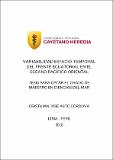Por favor, use este identificador para citar o enlazar este ítem:
https://hdl.handle.net/20.500.12958/3236Registro completo de metadatos
| Campo DC | Valor | Lengua/Idioma |
|---|---|---|
| dc.contributor.author | Asto Córdova, Cristhian José | - |
| dc.date.accessioned | 2018-08-27T20:06:42Z | - |
| dc.date.available | 2018-08-27T20:06:42Z | - |
| dc.date.issued | 2018 | - |
| dc.identifier.uri | https://hdl.handle.net/20.500.12958/3236 | - |
| dc.description | Tesis (Maestro Ciencia del Mar).- Universidad Peruana Cayetano Heredia | es_ES |
| dc.description.abstract | En el Pacífico Oriental el Frente Ecuatorial (FE) separa las Aguas Ecuatoriales Superficiales al sur de las Aguas Tropicales Superficiales al norte. Además está asociado a intensos gradientes horizontales de propiedades (físicas y biogeoquímicas) entre estas dos masas de agua. Estudios previos describieron al FE de manera sucinta, identificándolo como una formación superficial permanente; sin embargo, poco se sabe de su variabilidad temporal debido a la falta de datos con alta resolución. Desde el 2010 el satélite SMOS recolecta de manera sinóptica y continua la salinidad superficial del mar (SSM). Utilizamos 6 años (2010-2015) de datos de SSM los cuales fueron validados con datos in-situ adquiridos simultáneamente. Se desarrolló un algoritmo para la detección del FE basado en los máximos gradientes de SSM y determinamos su variación espacio-temporal. Estacionalmente, al oeste de Galápagos el FE está centrado en ~2°N y no mostró migraciones meridionales importantes. Al contrario, al este, mostró desplazamientos mayores, ubicándose ~4°S en primavera y ~2°N en otoño. Intraestacionalmente, el FE tuvo ligeras fluctuaciones meridionales, oscilando entre ±1.25°. La variabilidad estacional observada no estuvo relacionada a los vientos mientras que la variación intraestacional coincidió con la propagación de Ondas Kelvin de hundimiento durante el 2014. | es_ES |
| dc.description.abstract | ABSTRACT In the Eastern Pacific, the Equatorial Front (EF) separates the Equatorial Surface Waters to the south from the Surface Tropical Waters to the north. It is also associated with intense horizontal gradients of properties (physical and biogeochemical) between these two water masses. Previous studies described the EF succinctly, identifying it as a permanent superficial formation; however, little is known about its temporal variability due to the lack of data with high resolution. Since 2010, the SMOS satellite has been collecting the sea surface salinity (SSS) in a synoptic and continuous manner. We used 6 years (2010-2015) of SSS data which were validated with in-situ data acquired simultaneously. An algorithm was developed for the detection of EF based on the maximum gradients of SSS and we determined its spatio-temporal variation. Seasonally, west of Galapagos the FE is centered at ~2°N and did not show significant southern migrations. On the contrary, to the east, it showed greater displacements, situating ~4°S in spring and ~2°N in autumn. Intraseasonal, the FE had slight meridian fluctuations, oscillating between ±1.25°. The variability observed was not related to the winds whereas intraseasonal fluctuations was shown to be related to the propagation of downwelling Kelvin Waves during 2014. | - |
| dc.language.iso | spa | es_ES |
| dc.publisher | Universidad Peruana Cayetano Heredia | - |
| dc.rights | info:eu-repo/semantics/openAccess | es_ES |
| dc.rights.uri | https://creativecommons.org/licenses/by/4.0/ | es_ES |
| dc.source | Instituto del Mar del Perú - IMARPE | es_ES |
| dc.source.uri | Repositorio Digital IMARPE | es_ES |
| dc.subject | Frente ecuatorial | es_ES |
| dc.subject | Salinidad superficial | es_ES |
| dc.subject | Variabilidad | es_ES |
| dc.subject | Aguas ecuatoriales | es_ES |
| dc.title | Variabilidad espacio-temporal del frente ecuatorial en el Oceáno Pacífico Oriental | es_ES |
| dc.type | info:eu-repo/semantics/masterThesis | es_ES |
| Aparece en las colecciones: | Tesis de Postgrado | |
Ficheros en este ítem:
| Fichero | Descripción | Tamaño | Formato | |
|---|---|---|---|---|
| Asto Cordova.pdf | 7,2 MB | Adobe PDF |  Visualizar/Abrir |
Este ítem está sujeto a una licencia Creative Commons Licencia Creative Commons

